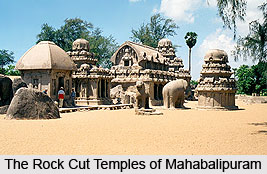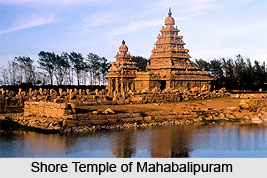 Architecture under Pallava dynasty is significant because it demonstrates the later development of the Dravidian style of architecture. The architecture of the Pallavas is classified into two periods. The earliest architecture of the Pallavas are the rock cut temples which dates back to 610-690A.D under the reign of the Mamalla rulers and the architecture of the structural temples dates back to 690-900A.D and these flourished under the Rajasimha Empire. The temples were mostly dedicated to Lord Shiva.
Architecture under Pallava dynasty is significant because it demonstrates the later development of the Dravidian style of architecture. The architecture of the Pallavas is classified into two periods. The earliest architecture of the Pallavas are the rock cut temples which dates back to 610-690A.D under the reign of the Mamalla rulers and the architecture of the structural temples dates back to 690-900A.D and these flourished under the Rajasimha Empire. The temples were mostly dedicated to Lord Shiva.
The rock cut temples of Mahabalipuram are the most magnificent features of Pallava architecture. It was built under the patronage of king Narasimhavarman I of the Mamalla period and thus it is also referred to as Mamallapuram. The first phase of the Pallava architecture is influenced by the Buddhist monasteries and chaitya halls. The principal architectural monuments of this period consist of some temples that are free standing sculptural replicas of contemporary structural temples or raths carved from the granolithic outcrops on the shore. These monuments are of the great importance for the later development of Dravid¬ian architecture because they reveal the depen¬dence of the later Hindu style on pre-existing types of Buddhist architecture. Especially re¬vealing for this latter aspect of the style is the Dharmaraja rath which has a square ground-storey with open verandahs that forms the base of the terraced pyramidal sikhara above. It has been rightly suggested that this typical Dravidian form is an adaptation of a Buddhist vihara, in which successive storeys were added for the accommodation of the monks. The terminal member of the structure is a bulbous sikhara, which is repeated in smaller scale on each of the lower levels of the terraced super¬structure. Perhaps the most distinctive feature of this and the other raths at Mahabalipuram lies in the open verandahs on the ground-storey. The pillars are of a distinctive Pallava type with the shafts of the columns supported by the bodies of seated lions.
 The Sahadeva"s rath, which is classified as the Vesara temple, represents a different type of architecture. The building is of a longitudinal type with a barrel roof. This mausoleum, terminating in the semi-dome of an apse and with the chaitya motif at its opposite end, is very clearly a survival of the Buddhist chaitya-hall that had persisted in such structural temples as the Gupta example at Chezarla and to a modified extent in the Durga temple at Aihole. The Bhima"s rath has a simple barrel roof with cross section and a chaitya arch on either side. It is crowned by a row of stupikas. Another distinguishing feature of the Pallava style of architecture is perceived in the Gavaksha motif of chaitya arches framing busts of deities that crown the entablature. This architectural feature is typical of the Dravidian style.
The Sahadeva"s rath, which is classified as the Vesara temple, represents a different type of architecture. The building is of a longitudinal type with a barrel roof. This mausoleum, terminating in the semi-dome of an apse and with the chaitya motif at its opposite end, is very clearly a survival of the Buddhist chaitya-hall that had persisted in such structural temples as the Gupta example at Chezarla and to a modified extent in the Durga temple at Aihole. The Bhima"s rath has a simple barrel roof with cross section and a chaitya arch on either side. It is crowned by a row of stupikas. Another distinguishing feature of the Pallava style of architecture is perceived in the Gavaksha motif of chaitya arches framing busts of deities that crown the entablature. This architectural feature is typical of the Dravidian style.
One of the raths of Mahabalipuram consists of a one-storey square cell surmounted by an overhanging, curvilinear roof, suggestive in its shape of the modern Bengali huts. This feature is an imitation of a proto¬type constructed of bamboo and thatch. The resemblance to the sikhara suggests that this most characteristically Dravidian element may also have had its origin in the form of a bamboo hut. The plastic embellishment of the raths consists of images of Hindu deities set in position on the exterior of the shrine, and also of panels exemplifying legends of Hindu myth¬ology ornamenting the interior of the sanctu¬aries. The figures appear to be a development from the style of the Later Andhra Period. The architecture retains the extremely refined attenuation of the forms at Amaravati, and is animated by the same feeling for movement and emotionally communicative poses and gesticulation. A new standard of propor¬tion is prominent in the heart-shaped faces with high cheekbones and the almost tubular overstatement of the thinness of the arms and legs. In the reliefs decorating the raths the forms are not so completely disengaged from the background as in the Andhra Period, but seem to be emerging from the medium of the stone.
The greatest architectural achievement of the Pallava artisans is the carving of an enormous granite boulder on the seashore with a representation of the Descent of the Ganges from the Himalayas. The scores of figures of men and animals, including those of the family of elephants, are represented in life size. The subject of the relief is that of all creatures great and small, the Gods in the skies, the holy men on the banks of the life giving flood, the nagas in its waves, and the members of the animal kingdom, one and all giving thanks to Lord Shiva for his astounding gift to the Indian world. The fissure in the centre of the giant boulder was at one time an actual channel for water, simulating the Descent of the Ganges from a basin at the top of a rock. In the relief at Mahabalipuram the shapes of the Gods moving like clouds across the top of the work of art, have the graceful, disembodied sophistication of the art of Amaravati. This gigantic, densely populated composition flows unrestrained over the entire available surface of the boulder from which it is carved.
The hallmark of Pallava architecture is also witnessed in the free-standing group of a monkey family in front of the tank below the great relief of the Descent of the Ganges. The understanding of the essential nature of the ani¬mals and the plastic realisation of their necessary form could barely be improved upon. This piece of architecture is the very personification of the principle mentioned in relation to the Indian canons of painting. The shapes, although only partially adumbrated, connote the finished form and pro¬claim the nature of the glyptic material from which they are hewn. In the panel of a cave in Mahabalipuram there is a relief which illustrates Durga fighting the demon buffalo, Mahisha. This episode is adapted from the Puranic legends. Goddess Durga is seated on a lion in this marvelous example of the Pallava style at its finest. She is eight-armed, and holds the weapons such as the bow, discus, and trident lent her by Lord Shiva and Lord Vishnu for the epic struggle. Her ornaments include a lofty head-dress, necklaces, jeweled belt; and her arms are covered with bracelets. This figure, like all Pallava architecture, belongs to the earliest and at the same time classic phase of Dravidian art. The whole conception is invested with a peculiarly dynamic quality that is always characteristic of Dravidian Hindu art.
After the death of the Pallava monarch Narasimha in 674 A.D. there was an end to the construction of raths and other sculptural work of Mahabalipuram. His successor Rajasimha was dedicated in the creation of structural buildings. The Pallava architecture experiences the transition from rock-cut architecture to stone temples. The Shore temple is an example of the later period of Pallava architecture. The figural canon in the Shore Temple of Mahabalipuram varies to a certain extent from the earlier architecture. The figure of the triumphant goddess of the Shore temple has a militant vigor conveyed by the moving pretense and the deploy¬ment of the arms in a kind of aureole. This is combined with a proposition of absolute seren¬ity and feminine softness, as is entirely appro¬priate to the notion of the divinity. The temple was planned in such a way that the door of the sanctuary opened to the east, in order to catch the first rays of the rising sun. This in itself resulted in a rather unusual arrangement, since it required the placing of the mandapa and the temple court at the rear or west end of the main sanctuary. The terraced spires crowning both shrine and porch very visibly reveal an expansion from the form of the Dharmaraja rath. In the Shore Temple, however, the depen¬dence on the vihara type is less marked, owing to the prominence on the height and slender-ness of the tower, like an attenuated version of the Dharmaraja rath. Actually, the character¬istic Dravidian form of a terraced architecture with the shape of the terminal stupika echoed in lesser replicas on the successive terraces still prevails, but these recessions are so ordered as to emphasise the verticality of the structure as a whole. Such distinguishing elements of the Pallava style as the pilasters with the extensive lions continue in the decoration of the portico of this structural monument.
The Kailasnatha temple at Kanchipuram is yet another architectural evidence of the Pallava dynasty. It dates back to 700 A.D. The architecture of the building consists of a sanctuary, a connecting pillared hall and a rectangular courtyard surrounding the entire complex. The pyramidal tower of the main shrine is again very obviously a development out of the Dharma¬raja rath. The storeys are manifested by heavy cornices and stupikas echoing the form of the cupola. There are a group of supplementary shrines around the base of the central spire that rhythmically reiterate the form of the terminal stupika. This shape is repeated once more in the row of cupolas crowning the ramparts of the patio. The gateways of the enclosure, surmounted by hull-shaped members of the vesara type repeating the form of Bhima`s rath at Mamallapuram, suggest the form of the temple towers of the last phase of Hindu architecture at Madura. As in the Shore Temple, pillars rising from rampant leonine forms are employed throughout.
The architecture of the Pallava dynasty was noteworthy because of it followed the idiom of Dravidian art and sculpture. The magnificent architecture of Mahabalipuram and Kanchipuram establish the foundation of the classical Dravidian architecture.



















